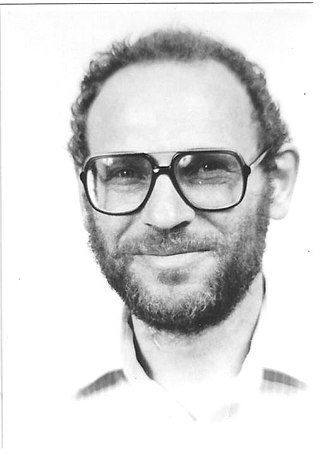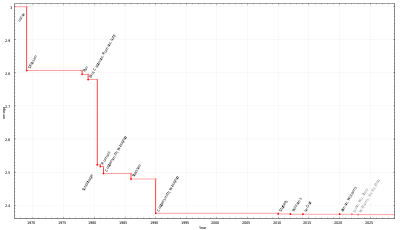In mathematics, the determinant is a scalar value that is a function of the entries of a square matrix. The determinant of a matrix A is commonly denoted det(A), det A, or |A|. Its value characterizes some properties of the matrix and the linear map represented, on a given basis, by the matrix. In particular, the determinant is nonzero if and only if the matrix is invertible and the corresponding linear map is an isomorphism. The determinant of a product of matrices is the product of their determinants.

In mathematics, Gaussian elimination, also known as row reduction, is an algorithm for solving systems of linear equations. It consists of a sequence of row-wise operations performed on the corresponding matrix of coefficients. This method can also be used to compute the rank of a matrix, the determinant of a square matrix, and the inverse of an invertible matrix. The method is named after Carl Friedrich Gauss (1777–1855). To perform row reduction on a matrix, one uses a sequence of elementary row operations to modify the matrix until the lower left-hand corner of the matrix is filled with zeros, as much as possible. There are three types of elementary row operations:

In mathematics, particularly in linear algebra, matrix multiplication is a binary operation that produces a matrix from two matrices. For matrix multiplication, the number of columns in the first matrix must be equal to the number of rows in the second matrix. The resulting matrix, known as the matrix product, has the number of rows of the first and the number of columns of the second matrix. The product of matrices A and B is denoted as AB.
In linear algebra, a Toeplitz matrix or diagonal-constant matrix, named after Otto Toeplitz, is a matrix in which each descending diagonal from left to right is constant. For instance, the following matrix is a Toeplitz matrix:
In linear algebra, an n-by-n square matrix A is called invertible if there exists an n-by-n square matrix B such that
In mathematics, the determinant of an m×m skew-symmetric matrix can always be written as the square of a polynomial in the matrix entries, a polynomial with integer coefficients that only depends on m. When m is odd, the polynomial is zero. When m is even, it is a nonzero polynomial of degree m/2, and is unique up to multiplication by ±1. The convention on skew-symmetric tridiagonal matrices, given below in the examples, then determines one specific polynomial, called the Pfaffian polynomial. The value of this polynomial, when applied to the entries of a skew-symmetric matrix, is called the Pfaffian of that matrix. The term Pfaffian was introduced by Cayley, who indirectly named them after Johann Friedrich Pfaff.
In linear algebra, the Strassen algorithm, named after Volker Strassen, is an algorithm for matrix multiplication. It is faster than the standard matrix multiplication algorithm for large matrices, with a better asymptotic complexity, although the naive algorithm is often better for smaller matrices. The Strassen algorithm is slower than the fastest known algorithms for extremely large matrices, but such galactic algorithms are not useful in practice, as they are much slower for matrices of practical size. For small matrices even faster algorithms exist.
In linear algebra, a circulant matrix is a square matrix in which all rows are composed of the same elements and each row is rotated one element to the right relative to the preceding row. It is a particular kind of Toeplitz matrix.
Matrix chain multiplication is an optimization problem concerning the most efficient way to multiply a given sequence of matrices. The problem is not actually to perform the multiplications, but merely to decide the sequence of the matrix multiplications involved. The problem may be solved using dynamic programming.
In numerical linear algebra, the method of successive over-relaxation (SOR) is a variant of the Gauss–Seidel method for solving a linear system of equations, resulting in faster convergence. A similar method can be used for any slowly converging iterative process.
Freivalds' algorithm is a probabilistic randomized algorithm used to verify matrix multiplication. Given three n × n matrices , , and , a general problem is to verify whether . A naïve algorithm would compute the product explicitly and compare term by term whether this product equals . However, the best known matrix multiplication algorithm runs in time. Freivalds' algorithm utilizes randomization in order to reduce this time bound to with high probability. In time the algorithm can verify a matrix product with probability of failure less than .

The following tables list the computational complexity of various algorithms for common mathematical operations.

Victor Yakovlevich Pan is a Soviet and American mathematician and computer scientist, known for his research on algorithms for polynomials and matrix multiplication.
Because matrix multiplication is such a central operation in many numerical algorithms, much work has been invested in making matrix multiplication algorithms efficient. Applications of matrix multiplication in computational problems are found in many fields including scientific computing and pattern recognition and in seemingly unrelated problems such as counting the paths through a graph. Many different algorithms have been designed for multiplying matrices on different types of hardware, including parallel and distributed systems, where the computational work is spread over multiple processors.
In computational complexity theory, arithmetic circuits are the standard model for computing polynomials. Informally, an arithmetic circuit takes as inputs either variables or numbers, and is allowed to either add or multiply two expressions it has already computed. Arithmetic circuits provide a formal way to understand the complexity of computing polynomials. The basic type of question in this line of research is "what is the most efficient way to compute a given polynomial ?"
Quantum complexity theory is the subfield of computational complexity theory that deals with complexity classes defined using quantum computers, a computational model based on quantum mechanics. It studies the hardness of computational problems in relation to these complexity classes, as well as the relationship between quantum complexity classes and classical complexity classes.
In numerical mathematics, hierarchical matrices (H-matrices) are used as data-sparse approximations of non-sparse matrices. While a sparse matrix of dimension can be represented efficiently in units of storage by storing only its non-zero entries, a non-sparse matrix would require units of storage, and using this type of matrices for large problems would therefore be prohibitively expensive in terms of storage and computing time. Hierarchical matrices provide an approximation requiring only units of storage, where is a parameter controlling the accuracy of the approximation. In typical applications, e.g., when discretizing integral equations, preconditioning the resulting systems of linear equations, or solving elliptic partial differential equations, a rank proportional to with a small constant is sufficient to ensure an accuracy of . Compared to many other data-sparse representations of non-sparse matrices, hierarchical matrices offer a major advantage: the results of matrix arithmetic operations like matrix multiplication, factorization or inversion can be approximated in operations, where
The spectral correlation density (SCD), sometimes also called the cyclic spectral density or spectral correlation function, is a function that describes the cross-spectral density of all pairs of frequency-shifted versions of a time-series. The spectral correlation density applies only to cyclostationary processes because stationary processes do not exhibit spectral correlation. Spectral correlation has been used both in signal detection and signal classification. The spectral correlation density is closely related to each of the bilinear time-frequency distributions, but is not considered one of Cohen's class of distributions.

Virginia Vassilevska Williams is a theoretical computer scientist and mathematician known for her research in computational complexity theory and algorithms. She is currently the Steven and Renee Finn Career Development Associate Professor of Electrical Engineering and Computer Science at the Massachusetts Institute of Technology. She is notable for her breakthrough results in fast matrix multiplication, for her work on dynamic algorithms, and for helping to develop the field of fine-grained complexity.
In mathematics and computer science, polynomial evaluation refers to computation of the value of a polynomial when its indeterminates are substituted for some values. In other words, evaluating the polynomial at consists of computing See also Polynomial ring § Polynomial evaluation




















































